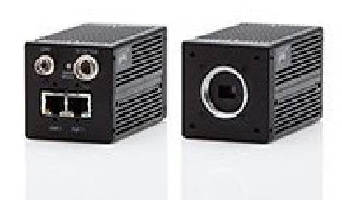Monochrome Camera utilizes dual CCDs.
Press Release Summary:

Combining different exposures from dual ICX447 CCDs in real-time, Model AD-131GE generates high dynamic range images with total resolution of 1.3 megapixels (1296 x 966). Precisely aligned 1/3 in. CCDs are mounted to beam-splitter prism, enabling camera to provide identical field of view to each CCD at full resolution speed of 31 fps. GigE Vision output is provided via 2 configurable RJ-45 ports, offering choice of single-cable or dual-cable operation. Monochrome output can be 8, 10, or 12-bit.
Original Press Release:
JAI Releases Monochrome Version of 1.3-Megapixel High Dynamic Range Camera
SAN JOSE, CA - Last month, JAI rolled out the AD-132GE, a 2-CCD camera that uses prism technology to produce high dynamic range (HDR) color images. Today, the company introduced the monochrome counterpart to that camera, the AD-131GE. Like its predecessor, the new AD-131GE intelligently combines different exposures from the camera's dual ICX447 CCDs in real time to generate high dynamic range (HDR) images with a total resolution of 1.3 megapixels (1296 x 966). Output from the camera is via a standard GigE Vision digital interface.
The HDR capability is made possible by having the two precisely aligned 1/3" CCDs mounted to a high performance beam-splitter prism. This enables the camera to provide an identical field of view to each CCD at a full resolution speed of 31 frames per second. The shutter speed and/or gain for each CCD can be calibrated independently such that one imager captures details in the brighter areas of a scene, and the second CCD captures the same image, but with an emphasis on the details in the darker areas. The two images or video streams can then be processed with in-camera image fusion algorithms to produce a dynamic range nearly double the normal CCD response.
Alternatively, users can choose to send the camera's raw video output to a host computer for post-processing using their own algorithms. Either way, JAI's high performance multi-imager technology enables the AD-131GE to achieve dynamic range levels as high as 20-bits per pixel (~120 dB) in a linear fashion that avoids the noise, rolling shutter, and compression issues found in comparable CMOS-based logarithmic or LinLog(TM) HDR cameras.
The AD-131GE is targeted at a range of applications where extreme lighting contrast affects image quality. These include inspection tasks where incident light or bright reflections are present, such as LED inspection, welding, glass inspection, solar panel manufacturing, and monitoring of industrial furnaces or heated metal. The camera is also ideal for microscopy applications, as well as high-end surveillance or traffic applications where sun and shadow or indoor/outdoor scenes make it difficult for conventional cameras to maintain exposure across the entire field of view. The parameters of each CCD can be adjusted by the user to provide maximum dynamic range or maximum contrast/sensitivity within a narrower lighting range, depending on the application.
Several other operating modes are provided to enable users to leverage the unique 2-CCD configuration for uses other than HDR imaging. For example, a high signal-to-noise (S/N) mode automatically averages the video information from the two CCDs to produce a single image with a significantly lower noise component than a typical single-CCD image of the same scene. A double-speed mode offsets the timing of the two CCDs by one-half frame and interleaves captured images into a single 1.3 megapixel output stream at 62 fps. Because this is done without any increase in the clock frequency of the camera, users can achieve high frame rates while keeping clock noise to an absolute minimum.
Also included is an advanced PIV mode, which leverages the camera's two-channel operation to capture three closely-spaced images on a single trigger instead of only two images captured by conventional PIV trigger modes. This allows 50% more data to be collected to better analyze ultra-fast events such as vortex forming in artificial heart chambers, combustion analysis in engines, and air flow studies in wind chambers, to name a few.
The AD-131GE's GigE Vision output is provided via two configurable RJ-45 ports, offering users a choice of single-cable or dual-cable operation depending on the mode used. Monochrome output can be either 8, 10, or 12-bit. Other features include partial scanning, blemish and shading compensation, as well as analog video output to support auto-iris lenses.
About JAI
JAI is a manufacturer of high quality, industrial-grade cameras for the machine vision, transportation, aerospace, homeland security, medical and scientific markets.
JAI's broad product line features high performance progressive scan CCD cameras with spatial resolutions from VGA to 16 megapixels; traditional interlaced video cameras; intensified cameras with sensitivity to light levels as low as .00001 lux, and a range of innovative multi-imager prism-block cameras including both area scan and line scan models.
Physical interfaces include the Camera Link® and GigE Vision® high performance digital standards, as well as both TV-standard and analog progressive scan output.
JAI cameras help improve customer businesses in a variety of ways, whether by improving quality and accuracy, lowering costs, increasing yields, or simply enabling better service. In addition to cameras, JAI's traffic solutions group is one of the world's leading manufacturers of specialized traffic systems. Solutions are based on JAI-developed hardware and software, which is often integrated with third-party products.




